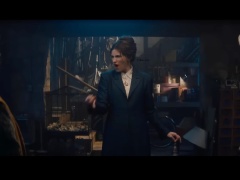
In the first episode, I feel that she’s very closed up. She’s never been tasked to become an interpreter or have any kind of important role in this male-dominant society,” Anna Sawai says of Lady Mariko, the character she plays in FX’s “Shōgun.”
In “Shōgun,” which is based on James Clavell’s novel of the same name and set in 1600 feudal
Japan, Lady Mariko is placed in charge of translating for Lord Toranaga (Hiroyuki Sanada) and Blackthorne (Cosmo Jarvis), a ship’s captain who enters a society as it prepares for war.
Initially, Lady Mariko is wary and doesn’t fully trust Blackthorne. She’s also been given a new purpose: “If she’s able to serve her Lord and his needs — which is to help him understand who this barbarian is — then she’s happy to do that,” Sawai explains.
‘Skibidi Toilet’: Flushing Out Audience Data on an Internet Phenomenon

How Lisa Vanderpump and Gordon Ramsay Set Aside Their Egos to Decide Whose Competitor Won 'Food Stars' Season 2's $250,000 Prize
Who Lady Mariko is at the beginning is very different from the woman she ends up becoming. The show’s artisans helped visualize Lady Mariko’s arc through their respective crafts.
As costume designer Carlos Rosario was conceptualizing her outfits, he found a line in episode six to be most useful in deciphering who she was. Buntaro (Shinnosuke Abe) complains to Toranaga that his wife, Mariko, “has always been ice.” Rosario also considered Mariko’s backstory and the assassination of her family — as the only survivor, he felt she was spiritless and without any heart. Initially, her costumes were mostly black and white.
“The first costumes have a black and gold curve. That was a specific pattern over that period to represent snow covering grass,” says Rosario. “I felt that that pattern was very symbolic of who Mariko was in that moment. Emotionally, she was dead inside.”

Rosario also used symbolism in his prints as another way of reflecting her emotional state throughout the series. The crane prints on her uchikake, her formal kimono, “were about freedom and her taking off.”
Notably, there were many layers to the costumes, which reflected what the women were going through at the time. “That itself felt like entrapment. The women are so tied down, controlled, and there’s not enough space to breathe,” notes Sawai.
Musically, composer Leopold Ross worked with his brother Atticus Ross to find Mariko’s theme, something that would reflect that stoicism and embody her poise. “We wanted a melody that sounded very delicate but had room to grow into something grand and powerful,” says Leopold.
The composers landed on a solo flute for Mariko. once they had that in place, Japan-based arranger-producer Taro Ishida added layers of traditional Japanese gagaku sounds and music — the imperial court music of the time. “That would allow us to reveal those layers as the season goes on.
Lord Toranaga gives Mariko a sense of purpose in her role as translator. She finds a new connection with Blackthorne and finds herself opening herself to a world of new possibilities that she never had
before. So Rosario incorporated red camellias into her costumes. “Red was important to me throughout. The way to incorporate that heart energy was to paint the camellias onto the winter canvas of her [outfit] to symbolically reflect that she was opening herself to life.”
As Mariko’s arc progresses, the crimson tone becomes more dominant in her color palette and
the patterns become bolder. Everything builds to episodes eight and nine where Mariko finally feels a release. “There’s only one place she’s going, and she’s going straight ahead, and I felt that liberation and determination,” says Sawai.
Buntaro asks Mariko to kill herself with him that night, so they die as husband and wife. Except Mariko rejects that, telling him death is an escape and not a way to be united. By episode nine, Mariko goes head-to-head with Ishido Kazunari (Takehiro Hira), the warlord, and confronts him. She tells him, “I will never be captive or hostage or confined.”
Her strength and willpower are at its strongest. When the castle gates are blocked, she takes on the
castle guards and fails. Mariko vows to commit seppuku, the ritual of suicide. But then Isihido grants her permission to leave Osaka. However, the castle comes under attack and Mariko declares she will give her life for the greater purpose. Mariko ends up dying in the explosion.
Cinematographer Sam McCurdy rarely put Mariko’s eye line below anyone else — a deliberate
choice. “She’s always standing front and center,” he says. “We stripped away the restrictions that we had earlier imposed on her. The camera language around her was always free. She was in charge of
her own [destiny] by that episode.” McCurdy wanted to give the character the weight she deserved, so in taking it further, they went with wider lenses with the closeups. “She took front and center for that episode, and we had never done that before,” he says.

Music also becomes specifically curated, coming in “during specific moments” but not many,
says Leopold.
When Mariko arrives and meets Ishido, her motif plays announcing her arrival, and then it’s silent until she declares she’s not taking part in the poetry competition. “The music applied has some pressure there because she’s taking a stand,” he explains.
Again, when she leaves in defiance, the music returns. It all culminates in her theme reaching its grandest moment when she’s in battle. “That’s her melody in her grandest fashion,” Leopold says.
When she declares she’s going to commit suicide, “it turns into this very defiant groove.”
By this point, Rosario’s patterns are bolder, but the fabrics are thicker, almost armor-like. “Everything feels so much more constructed and architectural,” he says.
When she’s fighting, Mariko wears a red, black and gold uchikake. The butterfly print on it was
symbolic of her transformation.

Rosario notes Lady Mariko’s journey to empowerment is not linear, so by the end, he embeds
some of the white seen in her earlier costumes.






